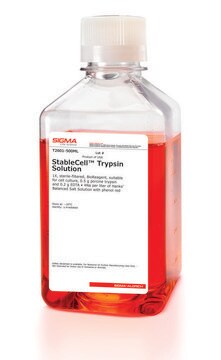T4174
Solution de trypsine-EDTA
10 ×, sterile-filtered, BioReagent, suitable for cell culture, 5.0 g porcine trypsin and 2 g EDTA, 4Na per liter of 0.9% sodium chloride
Synonyme(s) :
Cocoonase, Tryptar, Tryptase
About This Item
Produits recommandés
Source biologique
Porcine
Niveau de qualité
Stérilité
sterile-filtered
Gamme de produits
BioReagent
Forme
solution
Poids mol.
23.4 kDa
Concentration
10 ×
Technique(s)
cell culture | mammalian: suitable
Impuretés
Porcine parvovirus, none detected (9 CFR)
pH
7.0-7.6
Conditions d'expédition
dry ice
Température de stockage
−20°C
Vous recherchez des produits similaires ? Visite Guide de comparaison des produits
Application
Trypsin-EDTA solution is used for the following applications:
- Used as a supplement in cell culture for their maintenance
- In harvesting cells grown to confluence
- to detach lentivirus-transduced macrophages
Actions biochimiques/physiologiques
Serine protease inhibitors, including DFP, TLCK, APMSF, AEBSEF, and aprotinin, amongst others, will inhibit Trypsin.
Composants
Attention
Notes préparatoires
Vous ne trouvez pas le bon produit ?
Essayez notre Outil de sélection de produits.
En option
Produit(s) apparenté(s)
Souvent commandé avec ce produit
Code de la classe de stockage
12 - Non Combustible Liquids
Classe de danger pour l'eau (WGK)
WGK 1
Point d'éclair (°F)
Not applicable
Point d'éclair (°C)
Not applicable
Faites votre choix parmi les versions les plus récentes :
Déjà en possession de ce produit ?
Retrouvez la documentation relative aux produits que vous avez récemment achetés dans la Bibliothèque de documents.
Les clients ont également consulté
Protocoles
Trypsin is frequently used in cell dissociation from adherent surfaces. We offer a wide variety of trypsin solutions to meet your specific cell line requirements, as well as protocols, troubleshooting ideas, and more.
Notre équipe de scientifiques dispose d'une expérience dans tous les secteurs de la recherche, notamment en sciences de la vie, science des matériaux, synthèse chimique, chromatographie, analyse et dans de nombreux autres domaines..
Contacter notre Service technique






